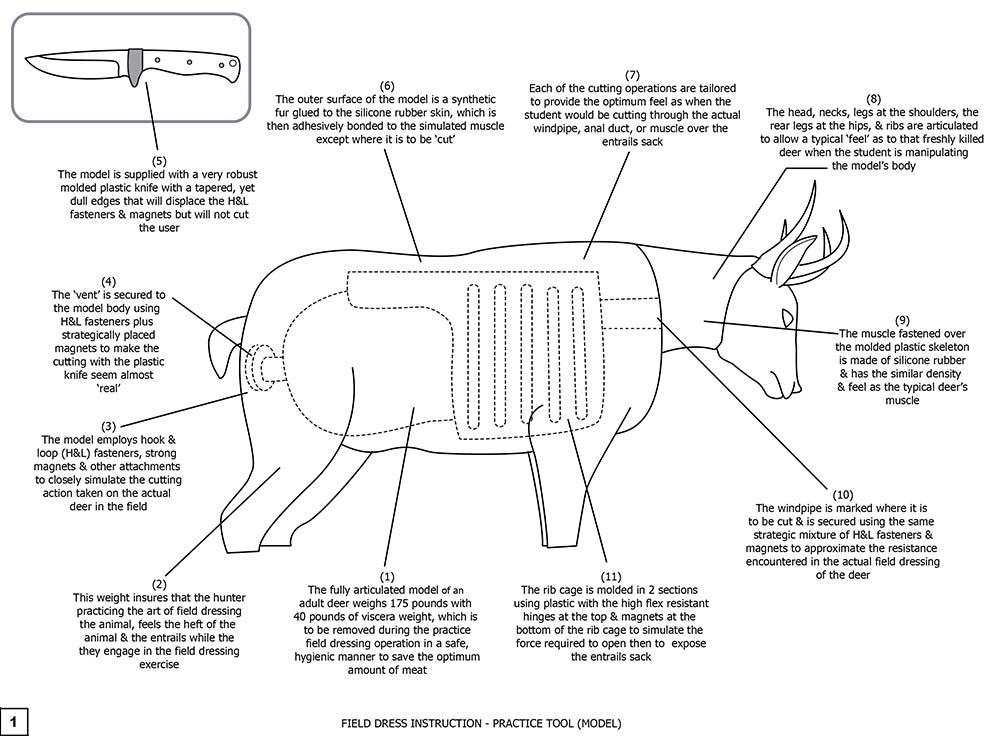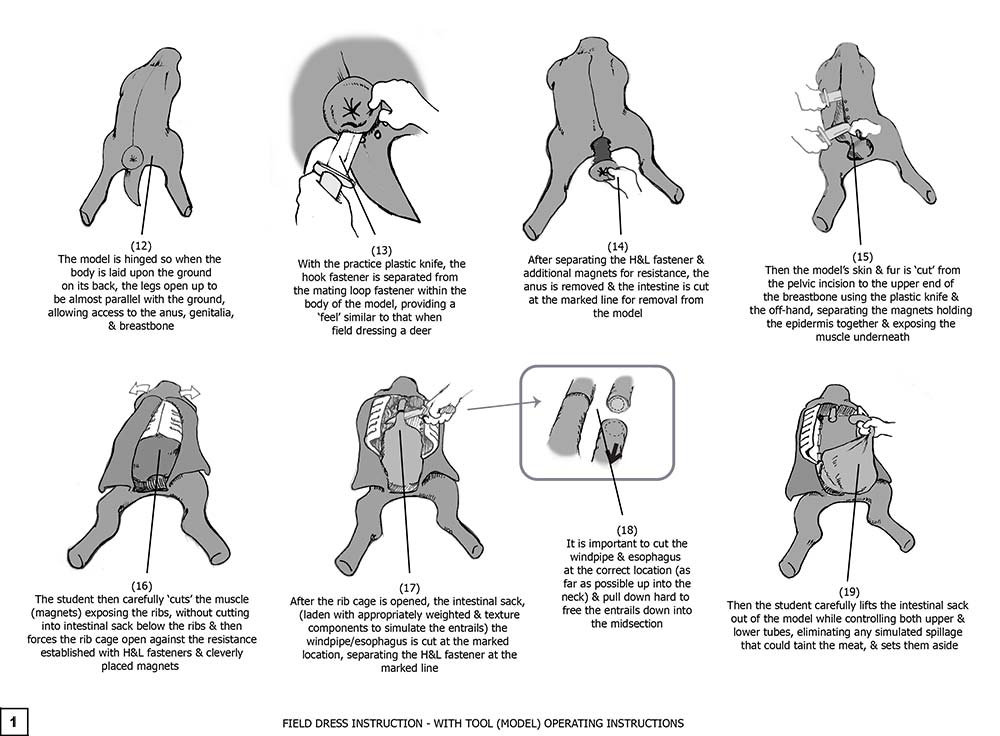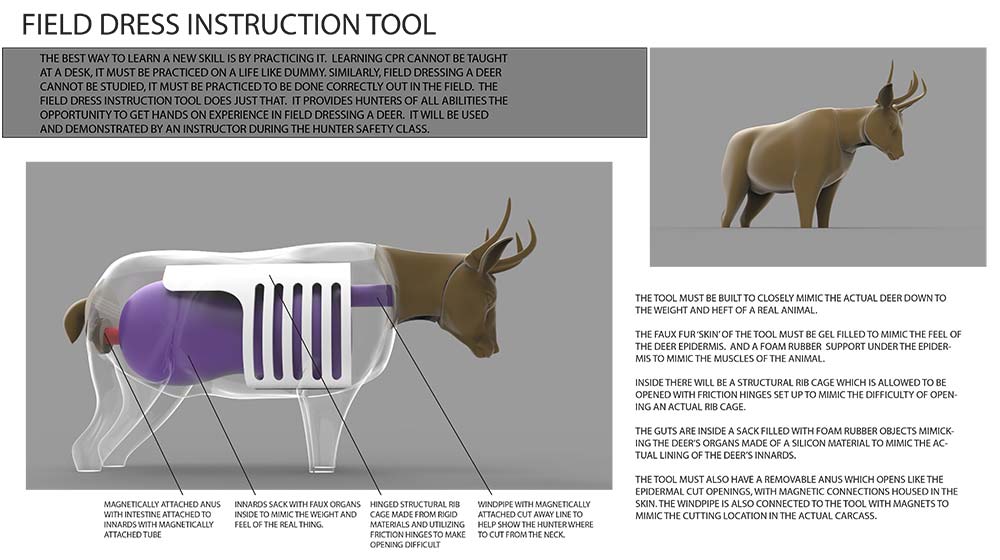
Field Dress Instruction Tool
DESCRIPTION:
Deer is a species of animal that is found in most places of the world and is a well- known and recognizable animal to hunt for either sport or subsistence. Deer have been known to humans throughout history and have pursued the deer for tens of thousands of years according to most historians. The discovery of ancient graphic pictographs in caves and dwellings representing deer is indicative of the essential role deer have played in the lives of early humans. Early hunters pursued deer for their valuable contributions of meat, hides, bones and other substances that ancient peoples found vital for their sociological needs and subsistence. The deer are ruminants, referring to the type of digestive system found in the mammals, forming the family Cervidae. Deer are present on almost all continents except Antarctica and Australia. The species of deer present in the United States are the mule deer, white-tailed deer, and the species would include the elk, caribou, and moose.
Hunting the deer as either a sport or as survival is an experience that is pursued by many people. The challenge of hunting deer is something that should be studied and practiced to become proficient at the activity. Tracking and pursuing deer is one style of modern hunting that takes skill and patience. Another type of deer hunting is hunting from blinds and deer stands where the deer are encouraged by feeding or other means to approach the waiting hunter. Regardless of the method used, once killed the issue of preparing the carcass becomes the primary focus of the deer hunter to preserve the deer for further processing.
Field dressing a deer is a necessary task for any serious deer hunter. The process of breaking down a deer carcass can be an intimidating and frustrating experience for those without experience or proper instruction. Incorrect field dressing on a recently killed deer can result in the total loss of the venison so getting the proper instruction on how to field dress a deer is vital to a successful hunt. Instructions on hunting should include a course on field dressing. The best way to learn is hand-on experience but that is often difficult in a learning environment that is just videos or an instructor pointing to photos or drawings. Getting to actually experience dressing the deer is always best but not always possible.
The Field Dress Instruction tool is an innovative and unique product that brings a close-as-possible experience of field dressing a deer into the classroom. The Field Dress Instruction tool is a life-size artificial carcass of a deer that can properly show how to gut and field dress an animal with a hands-on level of understanding. The Field Dress Instruction tool consists of a gel-filled fur epidermis to mimic the feel of the actual animal. Foam rubber supports located under the epidermis represent the muscles of the deer. The interior of the product contains a structural rib cage that comes complete with resistant hinges that simulate the difficulty of opening a rib cage. The interior organs are represented by a lined sack filled with the simulated deer organs fabricated from foam rubber and silicon-based materials. The Field Dress Instruction tool features a removable anus constructed with a magnetic resistance system to simulate the cutting out of the anus. The actual cutting is performed with a plastic knife in place of the real field knife. The magnetic connections are also positioned on a simulated windpipe located in the forward section of the product. These connections offer resistance when practicing cutting out the anus and severing windpipe with the plastic field knife. A line on the windpipe will indicate where to cut the windpipe. The male genitalia of the carcass is also represented and can be detached to represent a female gender. The Field Dress Instruction tool represents a functional learning experience using a reusable simulated deer carcass for a hands-on learning experience for deer hunters learning proper field dressing.
SPECIFIC, UNIQUE FUNCTIONS OF INVENTION:
- Simulates hand-on learning experience
- Product can be reused indefinitely
- Lifelike carcass
- Simulates interior organs
- Male or female genders represented
- Simulated fur and muscles
- Rib cage simulates difficulty of opening
- Removable anus with magnetic resistance for creating actual feel of cutting
- Windpipe indicates where it should be severed
- Windpipe used same magnetic resistance technology
- Quality and durable materials
PRODUCT COMPONENT CLARIFICATION:
The “Field Dress Instruction” is an innovative hunting education product that has been designed to teach hunters the proper way to field dress a deer before exiting the forest. The product is an anatomical model of an adult deer that has been altered to teach the optimum sequence and methods of field dressing a deer. The model has a molded plastic skeleton upon which simulated muscle and skin has been applied. Certain portions of the model have been secured within using hook and loop (H&L) fasteners and magnets to simulate the effort of cutting with the supplied plastic knife. The model (tool) can be field dressed by a student and then re-assembled to make it ready for the next practitioner.
The deer, after being shot in the field, should be dressed out quickly to provide the optimum amount of untainted meet for the hunter to enjoy. This process of field dressing is most often taught by a skilled hunter to an apprentice hunter that they have taken on a hunt. If the hunter does not have a mentor, they often do not have any idea about the process and optimum methods. The “Field Dress Instruction” provides a method that allows the new hunter to experience most of the problems associated with dressing out a deer in a controlled environment with a qualified instructor providing help and advice.
The deer should always be dressed out as soon as possible after it is harvested. There are many reasons why but the four most important are as follows.
- The primary reason is to make sure the meat cools quickly. The organs inside the cavity all generate heat. By removing those organs, the heat is removed from the body of the deer, and you let ambient air into the cavity to cool the rest of the meat.
- Field dressing also gets rid of much of the remaining blood in the deer.
- Field dressing also removes bacteria from inside the body cavity. The digestive tract contains bacteria to break down the deer’s food. If any of these organs are penetrated with a bullet or arrow, the bacteria will soon contaminate the meat.
- Removal of the intestines will lighten the load by as much as 25%. This makes carrying or dragging the carcass out of the woods much easier.
The anatomical model: The teaching tool is an anatomical model with articulated joints. The components are molded around the skeleton and then the skin with fur is adhesively bonded to various sections. Anywhere the molded plastic knife is to cut, the attachments are made using strategic locations of H&L fasteners intermixed with small magnets to simulate the effort required to cut as well as to allow the material to separate as required by the process. The weight of the animal is simulated with the model weighing about 175 pounds with approximately 40 pounds of viscera weight. The sex of the deer can be adjusted by removing the antlers and penis and applying the udder, all of which are held on with strong magnets. After use, re-assembly is easy to achieve, allowing expedient set up for the next student. The model (tool) is made using, but not limited to, the following materials.
- The skeleton: This is fabricated using polypropylene plastic ‘bones’ that are held together with stainless steel wires, operating as hinges. These bones are milky white to simulate typical bone color. This allows the silicone rubber muscle to provide the resistance that the typical deer has. The ribs are molded with a hinge at the upper back and are held together with strong magnets to simulated the force required to force them open to remove the viscera sack.
- The muscle: This is approximated with a silicone rubber foam that is molded around and over the skeleton. It is dyed pink to match normal muscle color and contrasts with the bone similar to a typical carcass. Most of the weight is in the muscle, just like a normal deer and this enhances the ‘feel’ as the model is being manipulated.
- The skin/fur: This is fabricated using a thin layer of very tough silicone rubber. It is off white and color and simulates the skin of the deer. To this, the 100% polyester faux deer fur fabric is attached to the skin using adhesive bonding techniques. The resultant skin/fur feels just like a typical deer skin. This sandwiched material is adhesively bonded to the silicone muscle of the model except in the areas where ‘cutting’ will be performed. There the skin and underlying muscle are held together using a mixture of H&L fasteners and strong magnets.
- The exterior bones: the horns and any other exterior bones are molded using polypropylene plastic that has been dyed to match typical horn or other exterior bones.
- The eyes: These are commercially available molded plastic units. They are placed into the molded cavities and adhesively bonded in place.
The Field Dress Instruction is designed to be aesthetic and effective in the application. The relative ease of manufacture and the reasonably inexpensive components provide good marketability for the manufacturer. The user benefits from the field dressing experience before they go on the hunt and the improved harvesting of the meat, which should provide considerable market interest in the product.
The invention is illustrated in the following drawings of the essential points as explained to us in the documentation.


Drawing 1, Block 1: Field Dress Instruction – Practice Tool (Model)
(1) The fully articulated model of an adult deer weighs 175 pounds with 40 pounds of viscera weight, which is to be removed during the practice field dressing operation in a safe, hygienic manner to save the optimum amount of meat.
(2) This weight insures the that the hunter practicing the art of field dressing the animal, feels the heft and the entrails while they engage in the field dressing exercise.
(3) The model employs hook and loop (H&L) fasteners, strong magnets, and other attachments to closely simulate the cutting action take on the actual deer in the field.
(4) The ‘vent’ is secured to the model body using H&L fasteners plus strategically placed magnets to make cutting with the plastic knife seem almost ‘real’.
(5) The model is supplied with a very robust molded plastic knife with a tapered, yet dull edges that will displace the H&L fasteners and magnets but will not cut the user.
(6) The outer surface of the model is a synthetic fur that is glued to the silicone rubber skin, which is then adhesively bonded to the simulated muscle except where it is to be ‘cut’.
(7) Each of the cutting operations are tailored to provide the optimum feel as when the student through the actual windpipe, anal duct, or muscle over the entrails sack.
(8) The head, neck, legs at the shoulders, the rear legs at the hips, and ribs are articulated to allow the typical ‘feel’ as to that freshly killed deer when the student is manipulating the model’s body.
(9) The muscle fastened over the molded plastic skeleton is made of silicone rubber and has the similar density and feel as the typical deer’s muscle.
(10) The windpipe is marked where it is to be cut and is secured using the same strategic mixture of H&L fasteners and magnets to approximate the same resistance encountered in the actual field dressing of the deer.
(11) The rib cage is molded in 2 sections using plastic with the high flex resistant hinges at the top and magnets at the bottom to simulate the force required to open and then to expose the entrails sack
Drawing 2, Block 1: Field Dress Instruction – With Tool (Model) Operating Instructions
(12) The model is hinged so when the body is laid upon the ground on its back, the legs open up almost parallel to with the ground allowing access to the anus, genitalia, and breastbone.
(13) With the plastic knife, the hook fastener is separated from the mating loop fastener with in the body of the model, providing a ‘feel’ similar to that when field dressing the deer.
(14) After separating the H&L fastener and additional magnets for resistance, the anus is removed and the intestine is cut at the marked line for removal from the model. Some hunters tie the anal tube off using a length of string to insure no leakage from the anal tube occurs.
(15) Then the model’s skin and fur is cut from the pelvic incision to the upper end of the breastbone using the plastic knife and the off-hand, separating the magnets holding the epidermis together and exposing the muscle underneath.
(16) The student then carefully ‘cuts’ the muscle (magnets) exposing the ribs without cutting the intestinal sack below the ribs and then forces the rib cage open against the resistance established with the H&L fasteners and cleverly placed magnets.
(17) After rib cage is opened, the intestinal sack (laden with the appropriately weighted and texture components to simulate the entrails), the windpipe/esophagus is cut at the marked location, separating the H&L fastener at the marked location.
(18) It is important to cut the windpipe and esophagus at the correct location (as far as possible up into the neck) and pull down sharply to free the entrails down into the midsection.
(19) Then the student carefully lifts the intestinal sack out of the model while controlling both the upper and lower tubes, eliminating any simulated spillage that could taint the meat, and sets them aside. As an alternative, if the student cannot easily lift and control the intestinal sack, they can roll the carcass onto its the side and carefully slide the entrails sack out of the body cavity.
After the exercise is over, the instructor can then reload the model, carefully making sure all the magnets and H&L fasteners are secured, making it ready for the next students instruction.
Although a single embodiment of the invention has been illustrated in the accompanying drawings and described in the above detailed description, it will be understood that the invention is not limited to the embodiment developed herein, but is capable of numerous rearrangements, modifications, substitutions of parts and elements without departing from the spirit and scope of the invention.
This document has been prepared for the manufacturer’s elucidation. The manufacturer’s decision makers should consider this product for licensing (providing intellectual property protection for their sales of the product in return for a royalty payment for a period of years) or an outright purchase of the patent for a negotiated fee. The inventor and his team are standing by to consider offers for licensing or outright purchase of the patent.


